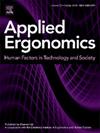机器人手臂设计和运动速度对人机交互的影响
IF 3.4
2区 工程技术
Q2 ENGINEERING, INDUSTRIAL
引用次数: 0
摘要
本实验旨在探讨机器人手臂尺寸、运动速度和自由度对协同拾取任务中感知安全、信任、心理负荷、人类行为和任务绩效的影响。56名参与者在虚拟现实环境中完成了实验,他们与机器人操纵者互动。与任务表现和人类行为相比,机器人手臂的速度对自我报告的影响更大。总的来说,惊讶和恐惧的平均评分在60度/秒的速度水平上显著增加(惊讶= 1.19/6;恐惧= 1.18/6),120度/秒(惊喜= 1.37/6;恐惧= 1.33/6),180度/秒(惊喜= 1.65/6;恐惧= 1.67/6)。相反,机械臂尺寸和自由度对任务表现和人类行为的影响比对自我报告结果的影响更大。这些发现可能为机器人制造商和标准委员会提供见解,以提高工作场所的感知安全性。本文章由计算机程序翻译,如有差异,请以英文原文为准。
Effects of robot arm design and movement speed during human-robot interaction
The purpose of this experiment was to investigate the effect of robot arm size, movement speed, and degrees of freedom on perceived safety, trust, mental workload, human behaviors, and task performance in a collaborative pick-and-place task. Fifty-six participants completed the experiment in a virtual reality environment where they interacted with a robot manipulator. Robot arm speed had a greater impact on self-reported measures, compared to task performance and human behavior. Overall, mean ratings of surprise and fear significantly increased across speed levels of 60 deg/s (surprise = 1.19/6; fear = 1.18/6), 120 deg/s (surprise = 1.37/6; fear = 1.33/6), and 180 deg/s (surprise = 1.65/6; fear = 1.67/6). Conversely, robot arm size and degrees of freedom had a greater influence on task performance and human behavior than on the self-reported outcomes. These findings may provide insights for robot manufacturers and standard committees to improve perceived safety in the workplace.
求助全文
通过发布文献求助,成功后即可免费获取论文全文。
去求助
来源期刊

Applied Ergonomics
工程技术-工程:工业
CiteScore
7.50
自引率
9.40%
发文量
248
审稿时长
53 days
期刊介绍:
Applied Ergonomics is aimed at ergonomists and all those interested in applying ergonomics/human factors in the design, planning and management of technical and social systems at work or leisure. Readership is truly international with subscribers in over 50 countries. Professionals for whom Applied Ergonomics is of interest include: ergonomists, designers, industrial engineers, health and safety specialists, systems engineers, design engineers, organizational psychologists, occupational health specialists and human-computer interaction specialists.
 求助内容:
求助内容: 应助结果提醒方式:
应助结果提醒方式:


